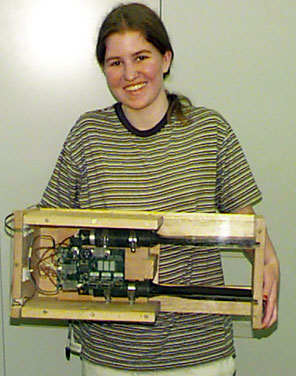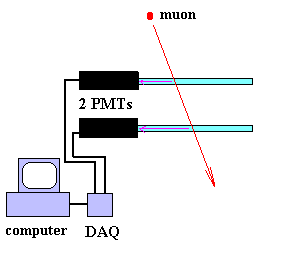 |
QuarkNetter Report: The Berkeley Detector |
 |

 |
QuarkNetter Report: The Berkeley Detector |
 |

The Berkeley detector, a highly portable coincidence muon detector, is easy to use and easy to understand. Becaues it runs on 12 volts, it can run on a simple power supply, an automobile cigarette lighter attachment or even a motorcycle battery. You can carry it easily and read it directly from its LED display or from a computer or graphing calculator (connection required). It counts continuously or in one minute intervals and can emit a "beep"each time there is a confirmed muon hit.
The Berkeley detector is optimal for taking muon counts in different places and at different altitudes. QuarkNet teachers have used it to demonstrate muon counting at a public evening at Brookhaven National Laboratory and to count muons at different altitudes in Colorado and Virginia. Teachers from Zimbabwe have borrowed it to count muons in the Southern Hemisphere. It is possible to borrow this detector directly from LBNL, although as its popularity grows, it will no doubt become more difficult to borrow.
 | Two plastic or glass scintillators are mated using optical glue and shaped fittings to two PMTs. The scintillators are covered with reflective material (aluminum foil works) and then with black paper and taped to make them "light-tight." They are hooked up to an analog-to-digital data aquisition board (DAQ). When a cosmic ray muon passes through each scintillator, it causes a few photons to be emitted by impurities in the scintillator material. These are picked up by the PMTs, converted to an electrical pulse and amplified. Each PMT sends its signal to the DAQ. The DAQ looks for "coincidences"—two signals (one from each PMT) are received within a very short time. These are reported to an LED counter; all others are vetoed as likely noise form the PMTs. The counter displays the number of muons that come in over an interval. |
You can build a Berkeley detector. The QuarkNet Centers at the University of Mississippi and Hampton University are working on that. The task can be daunting for two reasons. First, the hardware is expensive (especially the PMTs and their Cockcroft-Walton bases) and, second, you must assemble the electronics. LBNL will supply an empty printed-circuit board, but they do not obtain or solder in the parts.
Daunting but not impossible . . . LBNL physicist Howard Matis, an enthusiastic proponent of this detector, is willing to help you by staying in touch, answering questions and giving good advice. His Website (see below) gives all kinds of information including a design, a parts list and photos to help you. If you are thinking of building a Berkeley detector, study the Website, get some advice . . . and go for it!There are drawbacks.
- Muon lifetime experiments are not possible with this detector.
- This detector is a "black box." Students cannot play with it either to assemble it or figure out how it works.
RATINGS
|
RESOURCES AND CONTACTSThe Cosmic Connection Contacts: Howard Matis is the godfather of the Berkeley detector. Ken Cecire has taken measurements with the Berkeley detector and is gaining experience on the construction side. |